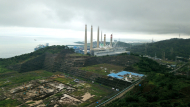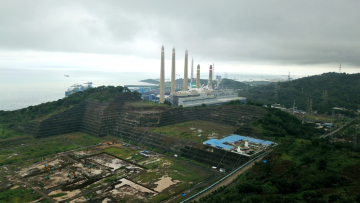Company – Target
This profile is a priority campaign targetBankTrack
Camilla Perotti, Banks and Coal Campaigner at BankTrack

Company – Target
This profile is a priority campaign targetBankTrack
Camilla Perotti, Banks and Coal Campaigner at BankTrack
Why this profile?
Perusahaan Listrik Negara (PLN) is the state-owned Indonesian utility company, actively developing fossil fuel projects across Indonesia, including massive coal- and gas-fired power plant projects.
What must happen
Banks should exclude corporate and project financing (including both lending and underwriting) to PLN until it ends the expansion of coal-fired power capacity and presents a concrete plan for phasing out coal by 2040.
Having the potential to drive Indonesia through a just energy transition, PLN must rapidly replace coal- and gas-fired plants with fair and sustainable renewable energy sources to be Paris-aligned, in line with the Climate Action Tracker pathway and the IEA's Indonesia net zero roadmap.
| Sectors | Electric Power Distribution , Biomass Electric Power Generation, Coal Electric Power Generation, Gas Electric Power Generation |
| Headquarters |
|
| Ownership |
PLN is completely controlled by the Indonesian state (100% equity). |
| Subsidiaries |
|
| Website | https://web.pln.co.id/en/about-us/company-profile |
PLN is a utility company wholly owned by the Indonesian government, with a near-monopoly on energy production and supply in Indonesia. Currently, coal remains the largest energy source in use in Indonesia, accounting for 72% of total domestic energy production.
PLN operates 137 coal-fired power plants and controls almost 64% of Indonesia’s operational on-grid coal power capacity (20,440 MW out of roughly 32,000 MW of Indonesian on-grid coal power capacity), clearly making the company the major operator of coal power assets in Indonesia. According to its 2025-2034 Electricity Supply Business Plan (RUPTL, in the Bahasa Indonesian acronym), PLN plans to add 16.6 GW of fossil power, 6.35 GW of which will be coal-generated. The new RUPTL also saw a downgrade of PLN’s renewables target from 20.9 GW in new clean power capacity additions by 2030 to 17.0 GW. With 1.6 GW already developed since 2021, the new RUPTL lowers renewables' goals by 2.3 GW. PLN once again chose to keep Indonesia tied to coal for the next ten years, instead of seizing the opportunity to launch the country into a just energy transition.
Impact on human rights and communities
Right to life
The Centre for Research on Energy and Clean Air (CREA) estimated that, in 2022 alone, air pollution due to coal power operations in Indonesia caused roughly 10,500 deaths and health costs of USD 7.4 billion. Considering PLN’s involvement in this energy sector (64%), we could state that, proportionally, PLN was responsible for 6,720 of those deaths and USD 4,73 billion in health costs. CREA also estimated that transboundary emissions from the Suralaya coal-power complex are contributing to over 2,500 premature deaths every year and causing widespread respiratory and cardiovascular diseases in the Jakarta metropolitan area.
Threats to public health
Impacts linked to PLN coal operations include thousands of premature deaths, cardiovascular diseases, respiratory illnesses such as bronchitis, asthma, tuberculosis and pulmonary obstructions, and skin rashes. These medical conditions disproportionately affect vulnerable populations, like children and the elderly.
In the vicinity of the Ombilin coal-fired power plant, research conducted in 2016-2017 found over 50 schoolchildren suffering from pulmonary disorders, from mild obstructions to bronchitis and tuberculosis. The school in question is located less than 500m from the coal power plant. Data collected by the Sawalunto municipality also highlighted that, in the period 2011-2020, Acute Respiratory Infection (ARI) has been, each year, the most common disease reported by citizens treated at the local health centre.
The same plant was also sanctioned in 2018 by Indonesia’s Ministry of Environment and Forestry for repeated violations of environmental regulations that also endangered public health. Two of the violations were already recorded in 2017: firstly, fly ash and bottom ash (FABA), waste products of the coal power process and classified as toxic hazardous waste, were found discarded in five unauthorised locations; secondly, the main chimney was found damaged, causing an uncontrolled dispersion of fly ash in the air. In 2019, research found that damage to the chimney’s air filter at the Ombilin plant could be linked to the high concentrations of PM2.5 in the air of Talawi District, far above legal standards, recorded on June 17th-21st, 2019. PLN still has not remedied these violations.
The Suralaya coal power complex is, according to CREA, actively causing widespread respiratory and cardiovascular diseases in the Jakarta metropolitan area. The costs and loss of income related to these health impacts exceed IDR 5.1 trillion (about USD 313 million) each year. These impacts and health costs are expected to rise once the Java 9&10 expansion becomes operational. The same report also highlights that transboundary pollution, caused by coal combustion for energy purposes and originating in the surrounding provinces of Banten and West Java, is a major contributor to air pollution in Jakarta City. Even during the COVID-19 pandemic, the air quality in Jakarta did not significantly improve, as satellite imagery showed that the Suralaya complex was operating and emitting at pre-pandemic levels. Winds brought this pollution into the Jakarta metropolitan area, which may have contributed to Jakarta’s PM2.5 levels remaining high despite major reductions in local traffic and urban activity due to COVID-19 restrictions.
Loss of livelihood
The Suralaya coal power complex, operational since 1984, has decimated the traditional farming and fishing livelihoods. Farmers struggle to grow crops, and traditional fishing techniques are becoming increasingly unviable. Banana trees and peanuts no longer thrive because of the pollution, including a thick dust that covers the plants. Once the Java 9&10 expansion units become operational, they will unequivocally exacerbate these well-documented impacts in an already endangered ecosystem.
The Cirebon coal-fired power plant, located in West Java, is not operated by PLN, but PLN is the exclusive buyer of the electricity produced by the power plant since the beginning of its operations in 2012. This business relationship has been continuing despite the numerous impacts lamented by the local communities: coal spills from the plant have caused severe damages to the marine biodiversity in the coastal region, marine habitats and traditional fishing grounds have been destroyed by the surge in barge traffic, local communities were displaced due to the plant’s expansions, and airborne coal dust and fly ash have contaminated agricultural lands and water sources, reducing crop yields and harming local flora and fauna.
Impact on climate
PLN operates the largest coal power fleet in Indonesia, with 137 coal-fired units totalling 21,026 MW capacity, far exceeding its renewable energy capacity of about 4,210 MW.
Coal power remains integral to the recently updated 10-year energy supply plan (RUPTL). Last updated in May 2025, it actually lowered clean energy targets, particularly in the near term between 2025 and 2029. The plan highlights a strong expansion of fossil fuel power (coal and gas) throughout 2034, in stark contrast with the Indonesian commitment to a Just Energy Transition Partnership (JETP) investment plan released in 2023 and with President Probowo’s vision for a phase-out of all fossil power by 2040. Indeed, the plan did not include any schedule for the retirement of operational plants. The 2025-2034 RUPTL sees an increase of 10% in fossil fuel power by 2030 over the earlier 2021-2030 RUPTL, with a plant to add 6.35 GW of new coal capacity by 2030. Phase-out by 2040 would require retiring 3 GW of coal power annually instead of adding double this amount.
According to the RUPTL, half of these 6.35 GW should be added already by the end of 2025: plants that should become operational include the Java 9 & 10 power units (2 GW), Lombok FTP2 (100 MW) for Lombok, Palu-3 (100 MW) for South Sulawesi and Sulut-1 (100MW) for North Sulawesi, Sumbagsel-1 (300 MW) and Sumsel-1 (600 MW) for Sumatra-Bangka, and the remaining three power stations with smaller capacities, Sofifi (6 MW) in Halmahera, Sorong (14 MW) in Sorong, and Kupang Baru (30 MW) in Timor. Among the projects planned to become operational in the next years, the RUPTL lists also Jambi-1 (600 MW), Jambi-2 (600 MW) and Parit Baru.
This further expansion of PLN’s coal activities will only further contribute to greenhouse emissions and air pollution, besides exacerbating the impacts on local communities throughout Indonesia.
The country's failure to implement policies to adequately reduce its emissions is closely linked to PLN's policies as the state electricity monopoly. The share of unabated coal power in the country's energy mix means that Indonesia's current energy policy is "critically insufficient" regarding alignment with the Paris goal of limiting global temperature rise to 1.5ºC. Instead, PLN’s current energy supply plans are aligned with a catastrophic scenario of 4+°C with potentially devastating consequences for the Indonesian population.
Impact on nature and environment
Biomass as a false solution
Co-firing power plants, which combine coal and biomass as energy sources, have been branded as an energy transition solution by the Indonesian government. Accordingly, PLN has planned to introduce co-firing in 107 of its coal power units in 52 different locations by the end of 2025, with biomass covering up to 10% of the energy source in these plants. This plan, however, has been marked as a false solution that would only prolong the use of coal in Indonesia. If PLN’s co-firing plans were fully implemented, a mere 1.5-2% of coal-related emissions would be reduced nationwide, against up to 2.1 million hectares of forest being cut each year. According to Trend Asia, Indonesia’s inefficient waste management would make it difficult to supply plants solely with waste biomass, making wood pellets the main source of biomass energy. PLN’s co-firing power plants would therefore require 10.23 million tons of wood pellets per year, which would translate into the deforestation of a surface equal to 35 times the area of Jakarta.
The increasing use of biomass as a domestic energy source would also further exacerbate issues associated with the large energy plantations that Indonesia has been developing in the past years, mostly for export to South Korea and Japan. These monoculture plantations have raised issues of land grab and the destruction of endemic species’ natural habitats.
PLN is entirely owned by the Indonesian state, which holds 100% of PLN's shares. According to the Banking on Climate Chaos report, between 2016 and 2023 commercial banks provided more than USD 9 billion in finance to PLN. See PLN's financiers below.










